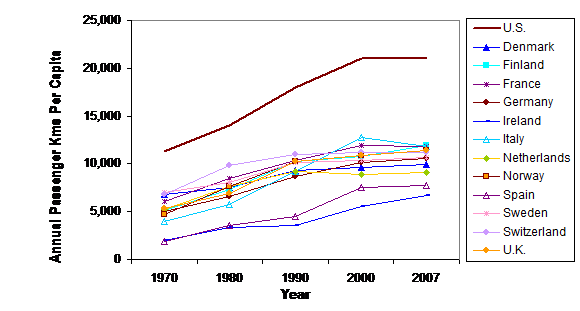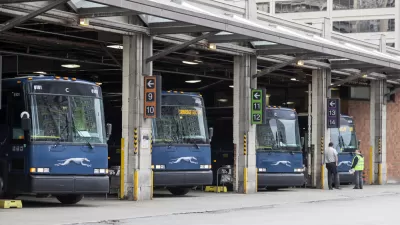The recently released report, Moving Cooler: Transportation Strategies to Reduce Greenhouse Gas Emissions, which recommends various VMT reduction strategies (also called mobility management, transportation demand management, TDM), has raised debate concerning the best way to reduce climate change emissions. Critics argue that that reducing vehicle travel is difficult and costly to consumers and the economy, and instead support strategies that change vehicle design (increased energy efficiency and alternative fuels).
The recently released report, Moving Cooler: Transportation Strategies to Reduce Greenhouse Gas Emissions, which recommends various VMT reduction strategies (also called mobility management, transportation demand management, TDM), has raised debate concerning the best way to reduce climate change emissions. Critics argue that that reducing vehicle travel is difficult and costly to consumers and the economy, and instead support strategies that change vehicle design (increased energy efficiency and alternative fuels). Proponents point out that VMT reduction strategies provide various co-benefits, including reduced congestion, road and parking facility cost savings, consumer savings, traffic safety, improved mobility for non-drivers, and improved public fitness and health, and so are often cost effective and beneficial overall, taking into account all impacts.
One way to approach this issue is to ask, What is the socially optimal level of mobility? What type and amount of mobility maximizes total net benefits to society, taking into account all benefits and costs? This question is investigated in my study, Socially Optimal Transport Prices and Markets. It estimates the type and amount of mobility that consumers would choose in an economically efficient transportation system. Such a system would reflect the following economic principles:
- Consumer options (consumers have a reasonable variety of transportation and land use options to choose from, including various modes, price and service quality levels, and locations for homes and services).
- Cost-based pricing (consumers pay the marginal costs of goods such as roads, parking facilities, fuel, vehicles, insurance, and pollution emissions).
- Economic neutrality (public policies do not arbitrarily favor one good or group over others).
Such a transportation system would be substantially different from what currently exists in North America. Vehicle ownership costs (fixed insurance and registration fees) would be somewhat lower but vehicle operating costs would be substantially higher since motorists would directly pay the full costs of roads and parking facilities (they currently pay much of these costs indirectly, through general taxes and rents), plus emission fees, and insurance and registration fees would be distance-based. Existing planning distortions that favor mobility over accessibility and automobile travel over other modes would be corrected; instead, least-cost transportation planning would select the most cost effective transportation improvements, taking into account all benefits and costs, and some tax and land use policies that favor automobile travel and sprawl would be changed.
This analysis suggests that in such conditions consumers would choose to drive significantly less than they currently do, rely more on alternative modes, choose to live in more accessible and multi-modal communities, and be significantly better off overall as a result due to various savings and benefits. Put differently, a third or more of existing automobile travel results from existing market distortions such as miss-priced roads, parking, and vehicle insurance; underinvestment in alternative modes and mobility management strategies; and land use policies that favor automobile-dependent sprawl.
This conclusion is supported by comparisons with mobility patterns in Northern European countries, which are economically similar to North America but residents drive significantly less due to higher fuel prices, more multi-modal land use planning, and land use development policies that discourage sprawl, as illustrated below. During the last few years, per capita vehicle travel peaked in most OECD countries, and the peak level is about half in affluent European countries as in the U.S.
International Vehicle Travel Trends 
Per capita vehicle travel grew rapidly between 1970 and 1990, but has since leveled off and is much lower in affluent European countries than in the U.S. (Based on data from the European Commission's "Energy and Transport In Figures" and the U.S. Federal Highway Administration's "Highway Statistics" reports.)
If it is true that in a more efficient market consumers would choose to drive significantly less (and I'm pretty confident about the basic conclusions although there is room for debate about details), there is considerable justification for the types of pricing and planning strategies recommended in Moving Cooler. Such reforms should be implemented regardless of emission reduction goals, since they benefit consumers overall and increase economic productivity. This is not a debate between conservative and liberal, or between environmentalists and the business community, it is simply a matter of good policy to increase economic efficiency and equity, and to help prepare for future travel demands, in anticipation of rising fuel prices, aging population, and growing health concerns.
Critics sometimes argue that mobility management strategies have been tried but failed in the U.S., citing examples such as a carpool lanes that attracted few users, but this is a miss-reading of actual experience. Many TDM programs are quite successful, provided that they include a combination of improved travel options (significantly better walking, cycling, ridesharing and public transit services) and pricing reforms (parking pricing or cash out and road tolls). The problem is that such programs have not been widely implemented so their total impacts have been modest.
Mobility management impacts can be quantified by multiplying the Sector (the type of travel affected, such as commute trips or local errands) X Penetration (the portion of the sector affected) X Impacts (the percent reduction in travel by affected trips). For example, a typical commute trip reduction program that includes parking pricing or cash out will reduce affected automobile trips 20%. If 25% of employees are affected by such programs, total impacts can be estimated at 0.20 (commuting represents about 20% of total personal travel) X 0.25 (portion of employees affected) X 0.20 (percent reduction by affected employees), or about 1% of total vehicle travel. Total impacts can be increased by expanding programs to include other sectors (such as children's travel to school, local errands and freight transport) and increasing penetration rates, so a greater share of people are affected.
There is an important technical issue to be considered in this analysis: the price sensitivity of vehicle travel. Critics argue that vehicle travel is inelastic, meaning that each 1% increase in price causes less than 1% reduction in vehicle travel, which implies that mobility demand is inflexible and attempts to reduce vehicle travel harm consumers. This is true if price components are considered individually, such as just fuel or just tolls, but when total vehicle costs are considered together (e.g., if fuel, road tolls, parking, and insurance fees all increased 1%) the long-run elasticity of vehicle travel is pretty high. This is why parking and insurance price reforms are as important as fuel price increases for increasing transport system efficiency.
North American fuel price elasticities declined during the 1980s and 90s. A study by Small and Van Dender found during the 1997-2001 period, the gasoline price elasticities was -0.09 in the short run and -0.40% in the long run, about half the values found during 1966-1996. This probably reflects unique factors during that period, including declining real fuel prices, peak baby boom employment and driving age, and roadway expansion that stimulated sprawl. More recent studies suggest that fuel price elasticities increased after 2006, and consumers are likely to be much more sensitive to fuel prices as real petroleum prices increase in the future due to declining production and increasing demand. Elasticities should also increase if travel options improve (better walking, cycling, ridesharing, public transit, telework, etc.) making it easier for people to reduce their vehicle travel.
This issue is particularly important because of the Rebound Effect, the tendency of motorists to drive more when operating more fuel efficient vehicles. For example, if fuel efficiency standards or feebates encourage motorists to purchase a 30 mile-per-gallon rather than a 20 mile-per-gallon vehicle, their fuel costs decline from 10¢ to 6.7¢ per mile when fuel is $2.00 per gallon, and from 20¢ to 13¢ per mile when fuel is $4.00 a gallon. To the degree that vehicle travel is sensitive to price these lower costs mean more annual miles. The additional vehicle travel reduces net energy conservation benefits and exacerbates other transportation problems such as congestion, road and parking facility costs, accidents and sprawl. Many studies ignore these impacts altogether or use the low short-run elasticity values found by Small and Van Dender. I believe that this significantly exaggerates the benefits of increasing vehicle fuel efficiency strategies and undervalues travel demand management solutions. More comprehensive analysis tends to increase the relative advantages of mobilty management solutions.
For more information<
Cambridge Systematics (2009), Moving Cooler: Transportation Strategies to Reduce Greenhouse Gas Emissions (www.movingcooler.info), co-sponsored by a variety of organizations; report at http://commerce.uli.org/misc/movingcooler.pdf; summary at http://commerce.uli.org/misc/movingcoolerexecsum.pdf
CBO (2003), Fuel Economy Standards Versus A Gasoline Tax, Congressional Budget Office (www.cbo.gov); at www.cbo.gov/ftpdocs/49xx/doc4917/12-24-03_CAFE.pdf
Kathleen Leotta (2007), Implementing the Most Effective TDM Strategies to Quickly Reduce Oil Consumption, Post Carbon Cities (http://postcarboncities.net); at http://postcarboncities.net/files/Leotta_ImplementingTDMtoQuicklyReduceOilConsumption.pdf
Todd Litman (2005), "Efficient Vehicles Versus Efficient Transportation," Transport Policy, Volume 12, Issue 2, pp. 121-129; at www.vtpi.org/cafe.pdf
Todd Litman (2007), Socially Optimal Transport Prices and Markets, Victoria Transport Policy Institute (www.vtpi.org); at www.vtpi.org/sotpm.pdf.
Todd Litman (2008), Smart Emission Reduction Strategies, VTPI (www.vtpi.org); at www.vtpi.org/ster.pdf
Todd Litman (2009), Are Vehicle Travel Reduction Targets Justified? Evaluating Mobility Management Policy Objectives Such As Targets To Reduce VMT And Increase Use Of Alternative Modes, Victoria Transport Policy Institute (www.vtpi.org); at www.vtpi.org/vmt_red.pdf
Peter Samuel and Todd Litman (2001), "Optimal Level of Automobile Dependency; A TQ Point/Counterpoint Exchange," Transportation Quarterly, Vol. 55, No. 1, Winter, pp. 5-32; at www.vtpi.org/OLOD_TQ_2001.pdf.

Alabama: Trump Terminates Settlements for Black Communities Harmed By Raw Sewage
Trump deemed the landmark civil rights agreement “illegal DEI and environmental justice policy.”

Study: Maui’s Plan to Convert Vacation Rentals to Long-Term Housing Could Cause Nearly $1 Billion Economic Loss
The plan would reduce visitor accommodation by 25% resulting in 1,900 jobs lost.

Why Should We Subsidize Public Transportation?
Many public transit agencies face financial stress due to rising costs, declining fare revenue, and declining subsidies. Transit advocates must provide a strong business case for increasing public transit funding.

Paris Bike Boom Leads to Steep Drop in Air Pollution
The French city’s air quality has improved dramatically in the past 20 years, coinciding with a growth in cycling.

Why Housing Costs More to Build in California Than in Texas
Hard costs like labor and materials combined with ‘soft’ costs such as permitting make building in the San Francisco Bay Area almost three times as costly as in Texas cities.

San Diego County Sees a Rise in Urban Coyotes
San Diego County experiences a rise in urban coyotes, as sightings become prevalent throughout its urban neighbourhoods and surrounding areas.
Urban Design for Planners 1: Software Tools
This six-course series explores essential urban design concepts using open source software and equips planners with the tools they need to participate fully in the urban design process.
Planning for Universal Design
Learn the tools for implementing Universal Design in planning regulations.
Smith Gee Studio
Alamo Area Metropolitan Planning Organization
City of Santa Clarita
Institute for Housing and Urban Development Studies (IHS)
City of Grandview
Harvard GSD Executive Education
Toledo-Lucas County Plan Commissions
Salt Lake City
NYU Wagner Graduate School of Public Service




























